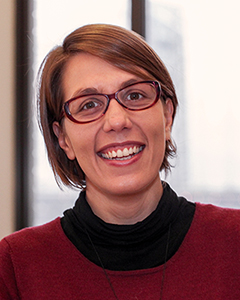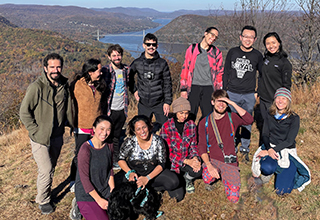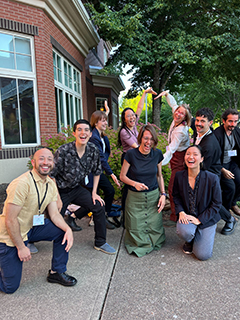September 19, 2023

The day her college atmospheric chemistry professor lectured about particulate matter, Marianthi-Anna Kioumourtzoglou, Sc.D., saw her career path: She wanted to study how those miniscule particles affect human health.
“This is what I’m doing!” the NIEHS grant recipient remembers enthusiastically telling a classmate.
At the time, however, she could not find a suitable public health program in Greece, her home nation, so Kioumourtzoglou instead pursued a bachelor’s degree in environmental engineering at the Democritus University of Thrace. But the public health field still beckoned, so after graduating, she packed up and moved to the United States.
After finishing a master’s program at the Gillings School of Global Public Health at the University of North Carolina at Chapel Hill, Kioumourtzoglou worked for a year as an air-resources engineer in California. She then completed her doctoral and postdoctoral work at Harvard’s T.H. Chan School of Public Health. Along the way, Kioumourtzoglou received an Environmental Protection Agency Star Fellowship, as well as NIEHS support through multiple Institutional Research Training Grants.
“Everything I have accomplished is because of NIEHS and EPA funding,” Kioumourtzoglou said. “The grants for my masters and doctoral work made it all possible.”
During her postdoctoral work, Kioumourtzoglou starting working with neurodegenerative outcomes, such as amyotrophic lateral sclerosis or ALS. Following this work, as faculty she examined possible links between air pollution and ALS. Her team found an association between particulate matter with diameter less than 2.5 μm (PM2.5) exposure and risk of an ALS diagnosis within six years. The study, supported by NIEHS, suggested a critical window during which PM2.5 might contribute to disease progression, according to Kioumourtzoglou.
Now, as an environmental engineer and epidemiologist at Columbia University, she studies the effects of air pollution and climate change on populations and develops innovative methods to study the health effects of environmental exposures.
Sifting Through Health Data More Efficiently
The year she joined Columbia’s faculty, Kioumourtzoglou received an NIEHS grant from the Powering Research Through Innovative Methods for Mixtures in Epidemiology (PRIME) Program, designed to improve how the health effects of mixtures are analyzed.
Traditionally, environmental health scientists have focused on the effects of one exposure at a time. However, in daily life, people encounter many types of contaminants to varying degrees over time. To make any progress on determining the impacts of environmental mixtures on health, Kioumourtzoglou needs rich data sets and methods to sift through that data quickly and efficiently.

For her PRIME project, Kioumourtzoglou and her team demonstrated how principal component pursuit, or PCP, a new type of algorithm initially developed for use in facial recognition and signal processing, could be used to find patterns in environmental exposures data. Specifically, Kioumourtzoglou and her collaborators are using PCP to find patterns representing shared sources of environmental exposures or behaviors that lead to exposures. If they can link these patterns to adverse health outcomes, their findings could lead to better regulations, interventions, and public health messaging around contaminant exposure.
“Adapting PCP to environmental health applications was not straightforward, as our data tend to be very noisy and messy,” Kioumourtzoglou noted, “but we were finally able to build a robust method that seems to work well.” She is now applying the PCP method to other projects.
She pointed out, however, the most important aspects of the grant were that it opened the world of mixtures research and connected her with other researchers. As part of her work, Kioumourtzoglou collaborated and co-authored a paper that serves as a tutorial for researchers interested in applying their methods to analyzing the associations between exposure to environmental mixtures and adverse health outcomes. The code they used was included to encourage others to reproduce their results.
Combining Pollution Models
As the PCP grant drew to a close, Kioumourtzoglou won another NIEHS methods-development grant, along with her mentor and collaborator, Francesca Dominici, Ph.D., a Harvard biostatistician, who is one of the principal investigators on the grant. They will address uncertainty in air pollution exposures in health studies. The idea grew out of conversations with another mentor at Harvard, biostatistician Brent Coull, Ph.D., who is now a collaborator on the project.
“Many researchers have created models to predict people’s exposures to air pollution, each with strengths and limitations that lead to different levels of uncertainty,” Kioumourtzoglou said. “Our team of epidemiologists, statisticians, data scientists, machine learning experts, atmospheric chemists, engineers, and other experts is using machine learning to integrate information from multiple air pollution prediction models at once. This process allows us to both quantify uncertainty in the data and understand better the factors contributing to it.”
The team is building models using nationwide data for multiple air pollutants, including for fine particles and nitrogen dioxide. They will investigate associations with adverse health outcomes on large datasets from Medicare, Medicaid, and hospitalization records from New York State, while propagating the estimated exposure uncertainty into their health models. Their progress is encouraging, Kioumourtzoglou said, noting that the team has presented results at prestigious machine learning conferences, like the highly competitive annual conference on Neural Information Processing Systems (NeurIPS), organized by the Institute of Electrical and Electronics Engineers.
Exposures and Pregnancy Outcomes
Kioumourtzoglou is also exploring new avenues in epidemiological research, with a focus on maternal and fetal health.
“I’m fascinated by impacts on health outcomes that have not been well studied, with respect to environmental exposures,” she said.
Interest in characterizing the health effects of air pollution on pregnant people and their children started picking up around 20 years ago, according to Kioumourtzoglou. Nonetheless, there remains very little understanding of the impacts of air pollution on pregnancy loss. Part of the challenge of studying pregnancy loss, specifically, is that losses can go undetected — some people miscarry before they know they are pregnant — and are therefore under-reported to the medical system. The lack of data makes it difficult to link pregnancy loss to air pollution directly.
“There is a lot of biological plausibility on why air pollution may be affecting pregnancy loss, but it’s very hard to study,” Kioumourtzoglou noted.
Seeing there was much new territory to explore in the field, she began to wonder — together with her mentor from her postdoctoral fellowship, Marc Weisskopf, Ph.D., Sc.D., of Harvard — what methods would allow more accurate estimation of the effects of air pollution on pregnancy loss.
With NIEHS support, she and Weisskopf have convened a team of colleagues from environmental epidemiology, biostatistics, and other public health disciplines to look into the specific factors of mixtures and pregnancy loss.
For their project, Kioumourtzoglou and collaborators are using data from Denmark, where the universal healthcare system generates large amounts of data on the whole population, captured in a network of health databases. The team is using that data to look at how maternal health factors — like autoimmune disorders, obesity, or smoking — as well as urban exposures and neighborhood characteristics, modify the association between air pollution and pregnancy loss. The team is also investigating which stages in pregnancy are the most vulnerable to environmental exposures.
“Hopefully, we will understand more about these associations and also identify other maternal or neighborhood factors that make these associations better or worse. That could inform more effective public health messaging and urban planning,” Kioumourtzoglou explained.
Epidemiology for the Future

Kioumourtzoglou has a keen interest in urban planning. She and her students, postdocs, and colleagues at Columbia are starting to examine the role neighborhood design plays in human health. They have already begun exploring ways to evaluate how cities’ environmental policies impact residents’ health and are currently applying for funding to support this new research direction.
“I want to make an impact, whether that is changes in cities that resulted from my studies, or stricter environmental standards for air pollution. What success in my research looks like is changes made in cities and policies based on my studies.”
Success, she added, depends on close collaboration with colleagues and trainees. Indeed, Kioumourtzoglou includes students of all levels in her research, because experience has taught her how important supportive mentors can be.
“I’m in academia because of the students,” she said. “My goal is to train thoughtful scientists who can go on to do good work afterward.”


